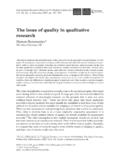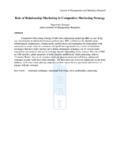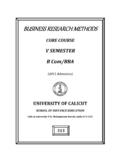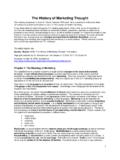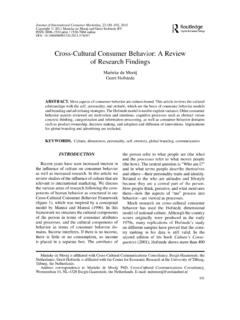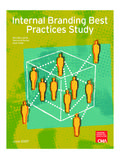Transcription of EJM Research design and data analysis in realism …
1 Research design and dataanalysis in realism researchRana SobhDepartment of marketing , University of Auckland, Auckland, New Zealand, andChad PerryDepartment of marketing and Management, Southern Cross University,Gold Coast, AustraliaAbstractPurpose The aim of this paper is to apply principles of the realism paradigm within qualitativeresearch The paper starts by establishing the usefulness of realismresearch for investigating marketing management phenomena, and then considers the implications ofthe realism paradigm for Research Issues such as the level of prior theory required, the use of replication logic andtriangulation are discussed.
2 In addition, guidelines for realism data analysis and reporting This paper provides an explicit set of principles for realism Research design anddata analysis that is different from those in other types of , design , data analysisPaper typeConceptual paperIntroductionMany researchers are concerned with the choice between a quantitative and aqualitative methodology. Essentially, quantitative researchers use numbers and largesamples to test theories, and qualitative researchers use words and meanings insmaller samples to build theories (for example, Easterby-Smithet al.)
3 , 1991). Someresearchers use only one type of methodology while others suggest that both typesmay sometimes be appropriate (Borch and Arthur, 1995; Hyde, 2000), even though thetwo methods may produce contradictory findings about the same phenomena, or atleast unrelated ones it is likely that quantitative methods and qualitative methodswill eventually answer questions that do not easily come together to provide a single,well-integrated picture of the situation (Patton, 1990, pp. 464-5).However, a core issue for researchers is not related to choice of methodologies butrelated to acknowledgement of the Research paradigms.
4 A methodology is only one ofthe three elements of a paradigm that researchers either explicitly or implicitly workwithin a paradigm includes the other elements of ontology and epistemology (Gubaand Lincoln, 1994). Essentially, ontology is reality , epistemology is the relationshipbetween that reality and the researcher, and methodology is the techniques used by theresearcher to discover that reality. In brief, a paradigm is an overall conceptualframework within which a researcher may work, that is, a paradigm can be regardedas the basic belief system or worldview that guides the investigator (Guba andLincoln, 1994, p.)
5 105). Philosophical assumptions that support four different paradigmsThe current issue and full text archive of this journal is available ,11/121194 Received February 2005 Revised August 2005and September 2005 European Journal of MarketingVol. 40 No. 11/12, 2006pp. 1194-1209qEmerald Group Publishing Limited0309-0566 DOI science positivism, realism , constructivism and critical theory are summarisedin Table these four paradigms is the question of knowledge creation: how can thefindings of one Research project be generalised to other situations? In the first of thefour paradigms, positivism, knowledge is statistically generalised to a population bystatistical analysis of observations about an easily accessible reality.
6 In the secondparadigm of realism , the findings of one study are extended by analyticalgeneralisation that shows how the empirical findings of a Research project nestlewithin theories (ontology cells, Table I). In other words, the aim of realism paradigm isto generalise to theoretical propositions and not to populations (Yin, 1989, p. 21). In theother two paradigms of constructivism and critical theory, reality is perception andso generalisation of one Research finding about someone s perceptions to anotherperson s theory about reality, cannot be done.
7 For example, in constructivism,findings are related to individual views of the world and create a world of multipleconstructed realities. Such views cannot be usefully compared with those of otherParadigmElementPositivismConstructi vismCritical theoryRealismOntologyReality is real andapprehensibleMultiple local andspecific constructed realities Virtual realityshaped by social,economic, ethnic,political, cultural,and gender values,crystallised overtimeReality is real butonly imperfectlyandprobabilisticallyapprehens ible andso triangulationfrom many sourcesis required to try toknow itEpistemologyFindings true researcher isobjective byviewing realitythrough a one-waymirror Created findings researcher is a passionateparticipant withinthe world beinginvestigatedValue mediatedfindings researcher is a transformativeintellectual whochanges the socialworld within whichparticipants liveFindings probablytrue researcher isvalue-aware andneeds to triangulateany perceptions heor she is
8 CollectingCommonmethodologiesMostly concernswith a testing oftheory. Thusmainly quantitativemethods such as:survey,experiments, andverification ofhypothesesIn-depthunstructuredintervie ws,participantobservation, actionresearch, andgrounded theoryresearchAction Research andparticipantobservationMainly qualitativemethods such ascase studies andconvergentinterviewsNote:Essentially, ontology is reality , epistemology is the relationship between that reality and theresearcher and methodology is the technique used by the researcher to discover that realitySource:Based on Perryet al.
9 (1999), which itself was based on Guba and Lincoln (1994) from whichthe quotations comeTable scientific paradigmsResearch designand dataanalysis1195individuals (as in post-modern Research ) (Bazeley, 2004). Similarly, in the critical theoryparadigm, perceptions are judged by their appropriateness to subjective conventionssuch as beauty and justice (as in feminist Research ) (Perryet al., 1999).Of the four paradigms, this paper will focus on marketing knowledge creationwithin the realism paradigm. In contrast to this paradigm, the positivism paradigmposition on knowledge creation about an easily apprehensible reality throughvalue-free procedures is well known, although it may often be inappropriate forreasons developed in the next section.
10 In addition, constructivism and critical theoryresearch will not be covered in detail here because they are explicit or implicit in muchqualitative Research literature. Their assumption that reality is a subjectiveconstruction is sometimes inappropriate for marketing management for reasonsdiscussed in the next the aim of this paper is to explain how realism Research can be designed tobuild knowledge about the external reality of marketing . Essentially, we argue thatworking within the realism paradigm requires procedures that are different fromprocedures in positivism, constructivism and critical theory paradigm Research .
